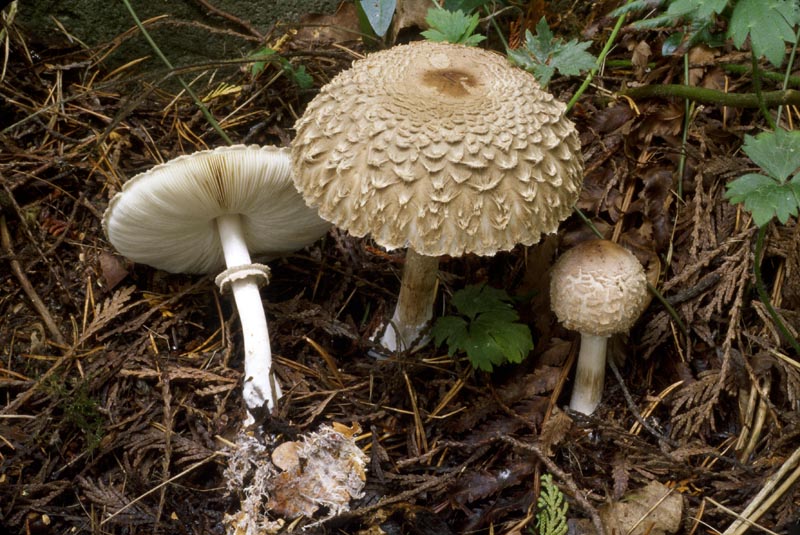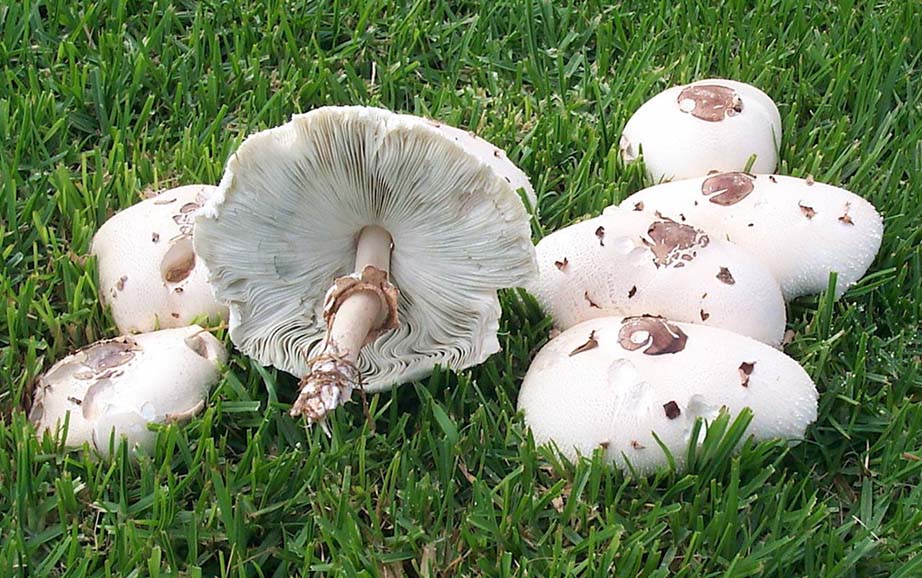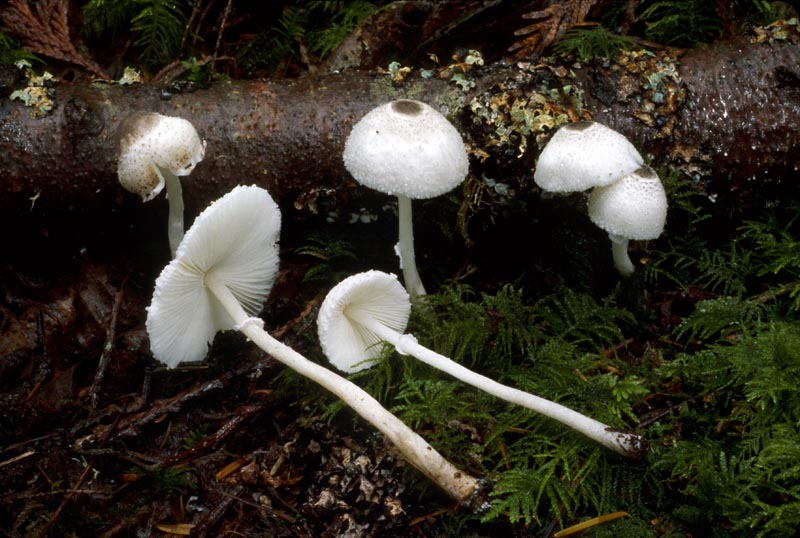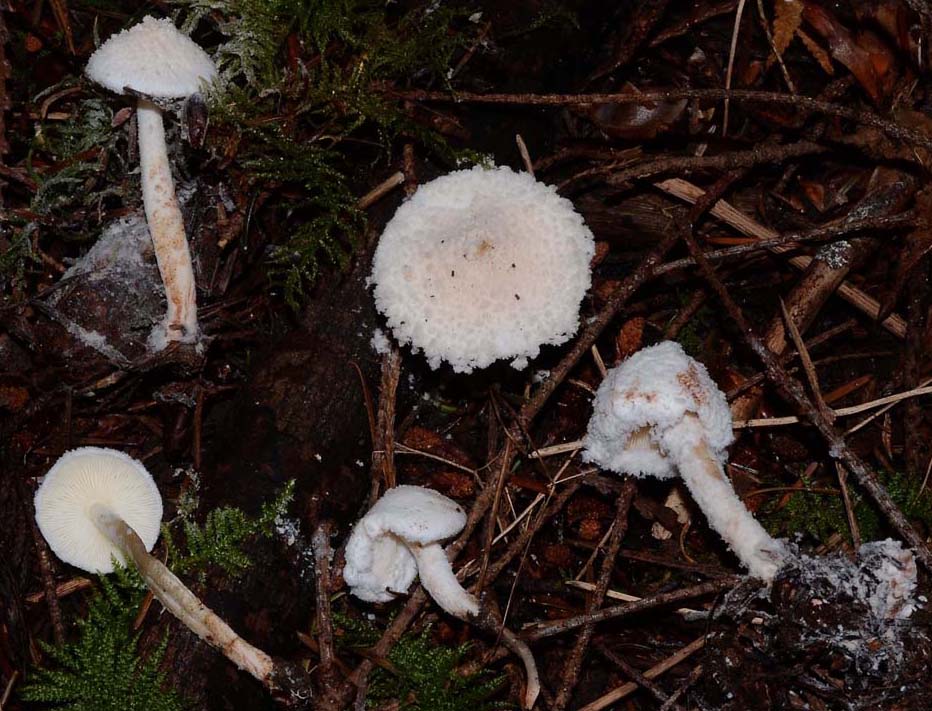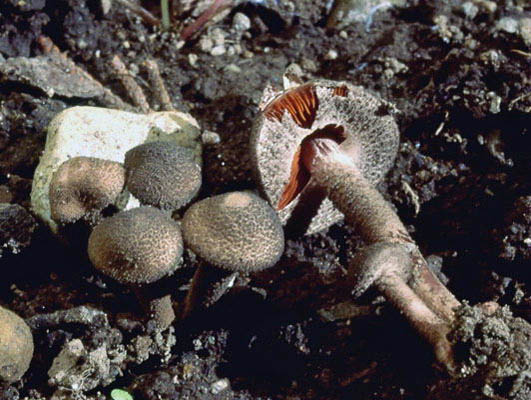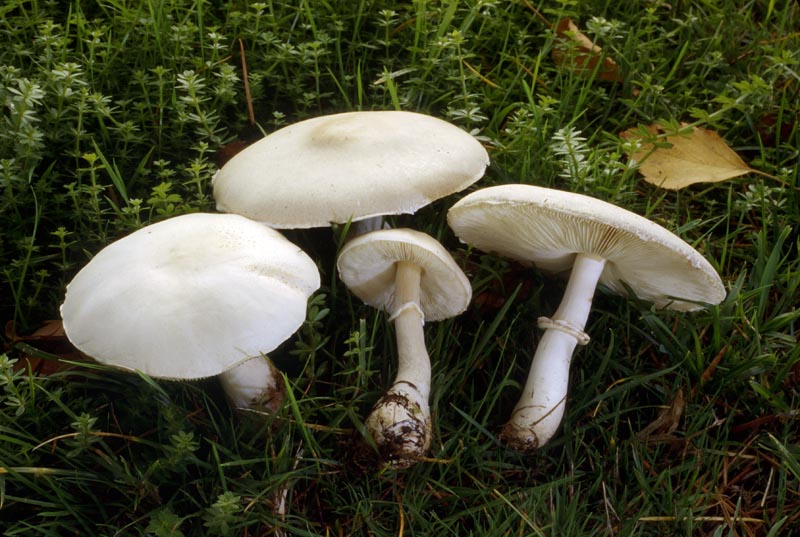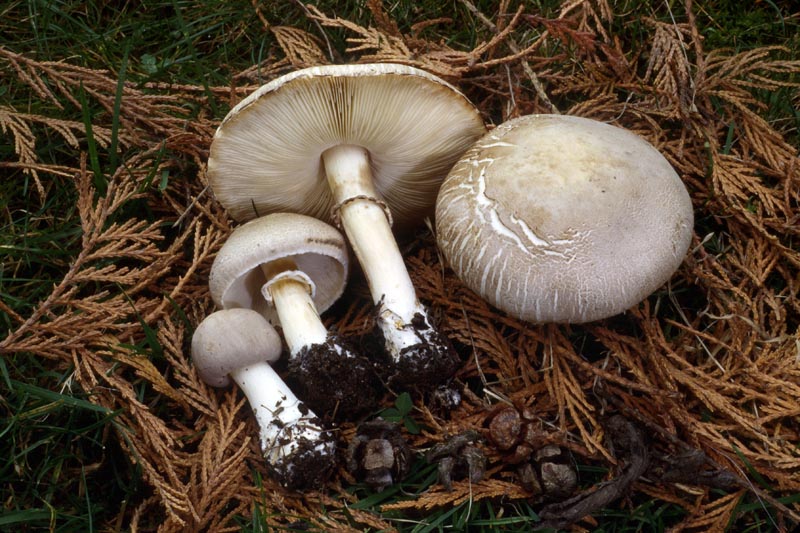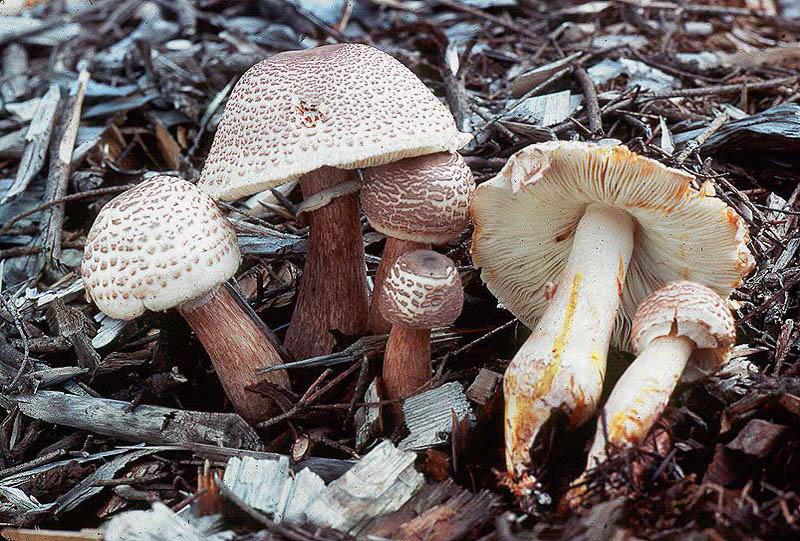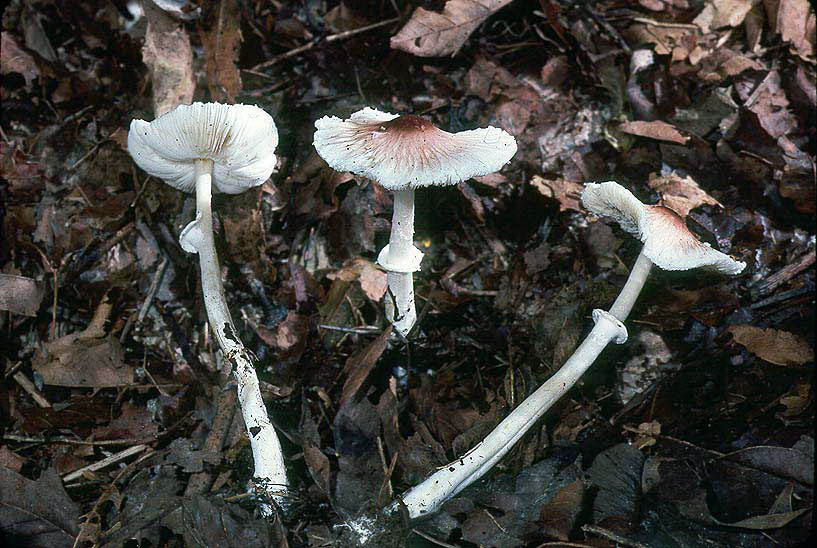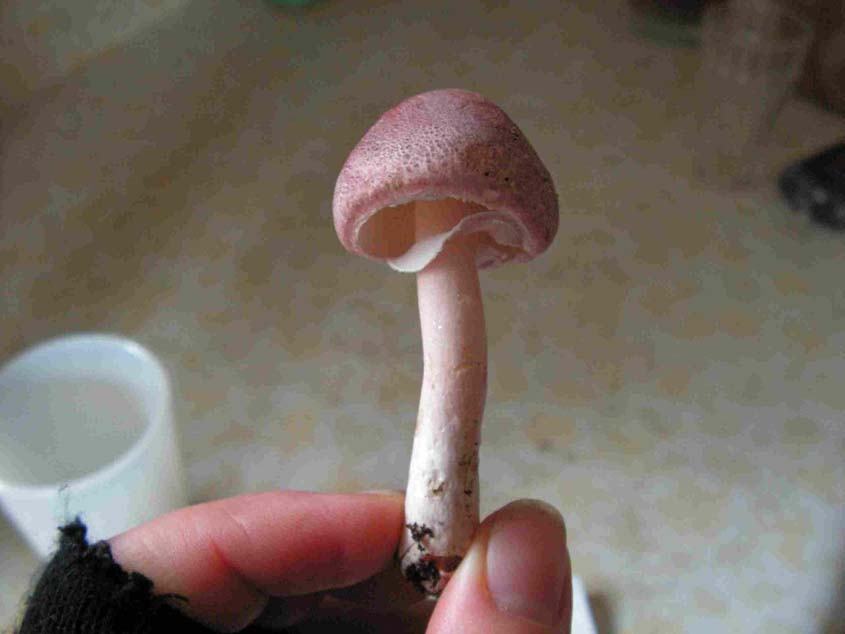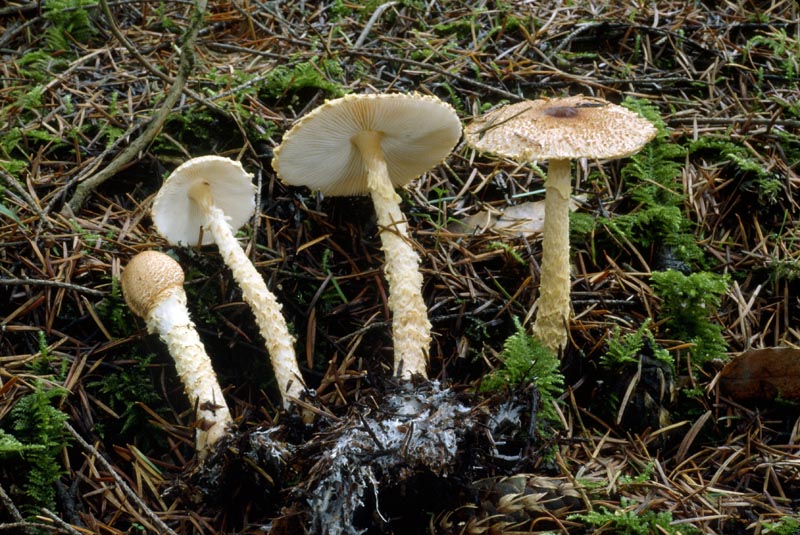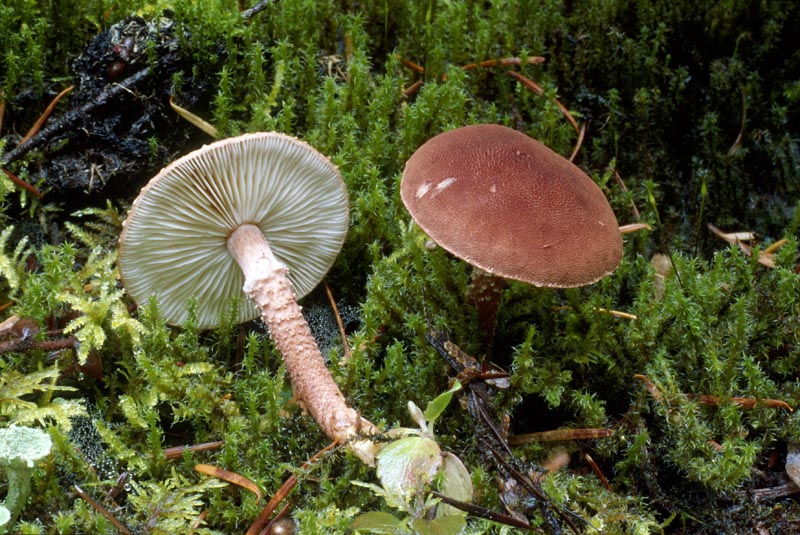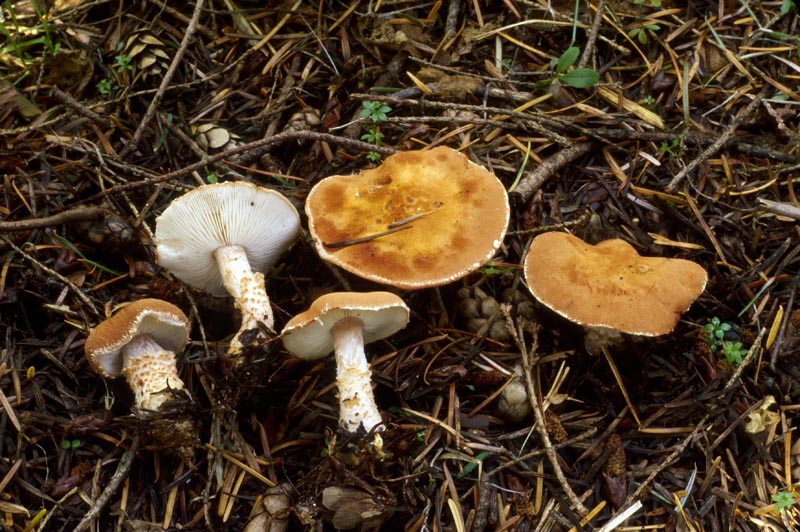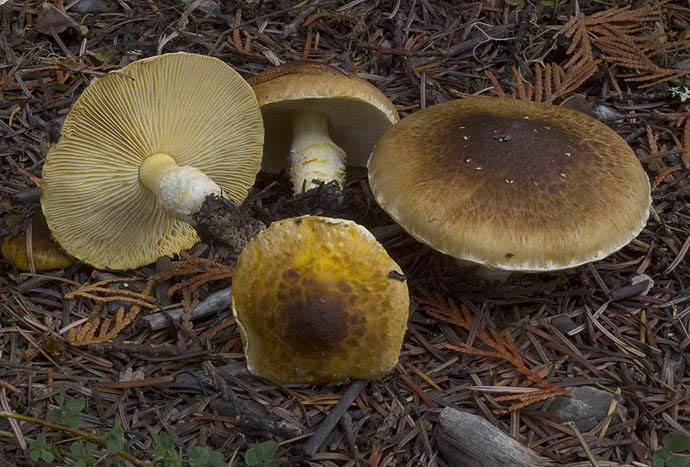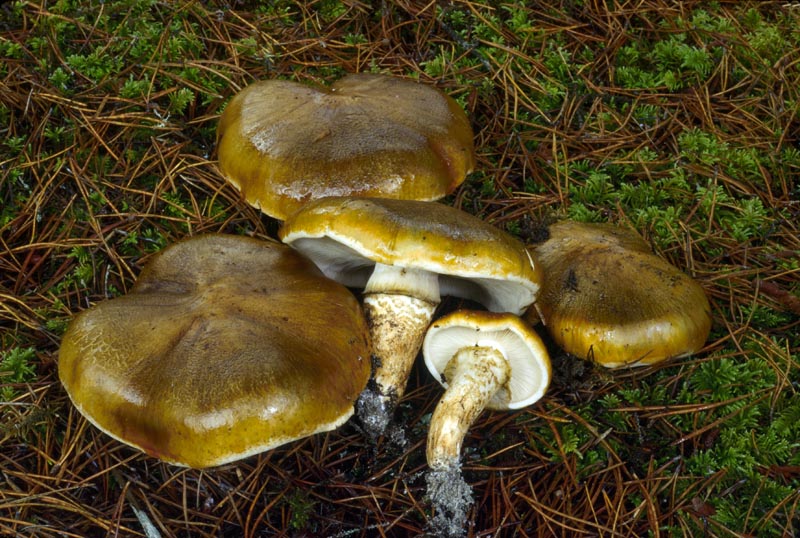Lepiota s.l.
Lepiota and allies are known for white spores, free gills,
and often scales on the cap that can't be removed (unlike the similarly
defined Amanitaceae that
have a universal veil that may leave warts, which unlike scales, are removable).
Unfortunately, some species violate all three of those generalizations.
All species seem to have some sort of obvious partial veil. Species in
this family often have a coloured "eye" in the cap disc where the scales
are especially dense. Like Amanita, some of them have evolved to produce the deadly
Amatoxin and can kill you if you eat them. Others are eaten regularly,
especially some Shaggy Parasols (Chlorophyllum) although one species of that can
be dangerously poisonous as well. While most Amanita are mycorrhizal,
most 'Lepiotaceae' are saprophytic.
Many 'Lepiotaceae' are closely related to the Agaricaceae.
Some are actually in that family (Leucoagaricus, Leucocoprinus, Chlorophyllum,
Macrolepiota, representing Agaricus that lost their spore pigment.
Laccaria is also a genus of white spored mushrooms in the dark spored clade
of agarics that lost their spore pigment). Other 'Lepiotaceae' are
closely related, in their own family, Verrucosporaceae (Lepiota,
Cystolepiota, Melanophyllum and Echinoderma).
Some genera not only lost their spore pigment, but also lost the free gills that
many of their relatives have, meaning that sometimes
the gills are attached to the stem. That makes them a bit more difficult to
identify as 'Lepiotaceae', but the scaly caps help. However, that's far from
foolproof as other scaly genera exist that are similar but totally unrelated,
like Tricholoma (which often will have specifically notched gills and seldom
have a partial veil, unlike the mushrooms on this page). These attached gilled
species are in their own family, the Squamanitaceae, except for
Cystodermella which is by itself.
To complicate things further, three genera re-evolved coloured spores
(or never lost all their pigments) - Phaeolepiota (pale
yellow- to orange-brown, described not here, but on the brown spored pages), Chlorophyllum (one has green spores) and Melanophyllum (green
or red!). That explains these rare spore colours not otherwise found.
Free gills:
- Chlorophyllum and Macrolepiota - large, shaggy
parasols. The stems of Chlorophyllum stain orange when cut or scratched.
- Echinoderma - medium to large species with erect scales
on the cap and staining colours, uncommon to rare.
(Small <2.5 cm species with erect scales and flesh that doesn't stain belong
in Lepiota).
- Leucocoprinus - try here first for the
small,
delicate fruitbodies (<5cm across) with a well developed
ring
that is often movable, granular-looking scale particles and a
striate margin
in age.
- Cystolepiota - try here first for small (<5cm
across) mushrooms with a shaggy overall appearance from cottony scales (that might wear off) and a
poorly developed ring.
Never striate.
- Melanophyllum - unique mushrooms
with red or green spores, a grey, scaly cap and red gills!
- Leucoagaricus and
Lepiota - everything else. Check Leucoagaricus
first for large mushrooms, or small mushrooms with smooth
stems that either don't have brown concentric scales on the cap
or that stain red (but rarely Leucoagaricus could be a small
mushroom with a smooth stem, not staining red with brown concentric scales).
Attached gills:
Chlorophyllum and Macrolepiota - the largest
mushrooms, 15cm or more across.
These are the shaggy parasols with scaly caps, of which we have
three relatively common local species. Formerly the differences were not recognized and they were
all just called Macrolepiota rhacodes. Luckily, our climate is usually too cool for the
very poisonous look-alike Chlorophyllum molybdites, with green spores
(from where we get the genus name, which means "green gilled"). That species is
mostly found south and east of us, but it has been found in Washington!
Cutting
Chlorophyllum will turn the flesh bright orange! (but not in
Macrolepiota). They have a well
developed ring on the stem that can usually be
moved up and down.
Do not confuse with Leucoagaricus americanus,
with a spindle shaped stem, different looking scales and staining yellow, orange
or red.
C. olivieri - the entire cap is brownish,
without any bright white visible underneath the scales. More rural.
C. brunneum - Contrasting cap from
the bright white under brown scales. Very abrupt bulb
on the stem. More urban. May not have scales when young!
This is what young C. brunneum looks like before the scales
develop on the cap. Note the crazy bulb.
C. rhacodes (rachodes) - Like C. brunneum but with a gradual
bulb. Fewer brown scales?
C. molybdites - very poisonous species in grass with a green tint
to the mature gills from green spores! Stains duller orange-brown than
the others.
Macrolepiota procera - scant brown scales on an otherwise white cap, not quite as large and
does not stain orange when scratched.
Only a few reports of escaped cultivars around Olympia, WA so far.
Echinoderma - medium to large species with erect scales
on the cap and staining colours, all pretty rare.
Although it is reported that our species are E. asperum and E.
eriophorum, our species are probably undescribed. Note that small species
(<2.5 cm) with erect scales with flesh that doesn't stain belong in
Lepiota.
Echinoderma spp. group
- dark brown scales, rather cold colours. Some may exude a
juice when fresh. They may have variable amounts of white showing
between scales, and the stems may vary in scaliness.
Echinoderma 'flavidoasperum' - warm yellow-brown scales
Echinoderma sp.
- at least one speices may sometimes be found mostly white.
Leucocoprinus - the smallest (<5cm
across) and most
delicate Lepiotas with a well developed
ring and granular scales
on the cap and somewhat on the stems. They have
striate margins, resembling the smaller
inky caps in
stature. These are usually more tropical species, and found more often in
greenhouses and potted plants than in the wild, although some species
manage to grow wild in the summer months. Very closely related to
Leucoagaricus
and possibly not deserving a genus of their own (they are "inside" Leucoagaricus
instead of "beside" it), but they are distinctive.
L. brebissonii - with a black eye in the
disc, in the wild in warmer weather. 'Lepiota'
atrodisca is similar but less delicate with a black edged ring and more
fibrillose cap scales.
L. heinemanii - larger, more fibrillose black scales without as
distinct an eye, found
in greenhouses.
L. cretaceus - all white with a more copious powdery covering than L. cepistipes
but still more granular than species of
Cystolepiota.
L. birnbaumii (luteus) - a yellow L.
cepistipes, found in flower pots.
L. flavescens - duller yellow
L. ianthinus - purplish, and found rarely in
flower pots.
Cystolepiota - small (<5cm across), often more
cottony overall than scaly with a poorly developed
ring. The shagginess will wear off
with age, however.
C. moelleri - similarly pale but covered in pink warts.
C. petasiformis - larger (>2.5cm) white species,
copious veil material often forming a false conehead. Smells farinaceous.
C. oregonensis ('hetieri') - very cottony, turns
orange-brown
where handled! <2.5cm. Possibly DEADLY.
C. fumosifolia - larger
(>2.5cm) with yellow-olive-brown discolouration.
C. 'bucknallii' - purple and shaggy! Smells
badly of coal-tar!
Melanophyllum haematospermum
is rare and has green or red spores and
free
red gills, a unique spore colour perhaps representing an intermediate stage
between the dark brown of Agaricus and the white of
Lepiota.
Melanophyllum haematospermum - red gills when young, fading and then harder to
ID. Well developed veil. Green or red spores depending on
how fresh the mushroom is.
Leucoagaricus
- LARGE mushrooms (cap ~10cm, stem 1-2cm thick) that are not Chlorophyllum
nor with erect
scales like Echinoderma
- SMALL mushrooms (cap <5cm, stem <0.5cm thick) with a
smooth stem and a ring
- try here first for small mushrooms that
stain red, have reddish
fibrils that radiate out from the cap centre instead of breaking up
individually or concentrically, and for those with pink, black or
mostly white scales
- (try Lepiota first for small mushrooms with a
brownish eye of concentric cap scales that do not stain
red appreciably)
First, the large species.
L. leucothites (naucinus) - Without scales,
it looks like a white Amanita without a
volva. Resembles Lepiota alba
when those shaggy stem scales have worn off.
Stem clavate.
Sometimes
the L. leucothites cap is greyish, and slightly shaggy.
L. barssii - like a greyish-brown L.
leucothites, but scalier. Stem tapers.
L. americanus (bresadolae) - like a medium sized
Chlorophyllum or a large Lepiota, but with a spindle shaped stem and no bulb.
Different parts may stain yellow, orange and red!
L. 'fuliginescens' - our sister species is more slender with a
longer stem than the real CA species.
Somewhat velvety brownish scales on a white background. Flesh stains orange-red (occasionally yellow) when damaged or old.
L. adelphicus - CA species recently found near Seattle. Dark brown
suede-like scaly cap, more subtly staining red-orange-purple
shades.
These species turn red where touched, sometimes dramatically so. Once
I actually jumped backwards and gasped it was so startling.
'Lepiota' flammeotincta - everything but the gills
turns red.
'Lepiota' castanescens - gills redden too. Not moved to
Leucoagaricus yet.
L.
erythrophaeus - gills redden as well, but a medium
sized stockier species that may have a collar around the stem that
the gills attach to.
These species have reddish brown fibrils that radiate out from the
centre instead of breaking up into individual scales or concentric circles
like most other species.
L. rubrotinctoides group - the reddish-brown scales radiate
from the centre in streaks, instead of the usual pattern of
concentric circles of scales. Smallish.
These species have pink or black scales on the cap, or they could be
pure white.
L. roseolividus - small beautiful lilac-pink
scaled species.
'Lepiota' decorata - medium beautiful pink
scaled species. Not yet moved to Leucoagaricus. Also consider the deadly
Lepiota subincarnata.
'Lepiota' atrodisca - black edged ring, small, but not as delicate as
the more coarsely scaly
Leucocoprinus brebissonii. Southern
species. Not yet moved to Leucoagaricus.
Leucoagaricus sp. 3 - uniform blackish grey scales all over the cap. Small to medium.
'Lepiota' sequoiarum - almost white, odorless.
Obscure scales. Slight colour on disc. Not yet moved to Leucoagaricus. Compare Cystolepiota and
Leucocoprinus cepistipes.
Leucoagaricus sp. 6 - similar all white species, more info
is needed.
Some species of Leucoagaricus resemble small Lepiotas and will be very
difficult to identify as Leucoagaricus. For instance, the rare 'Lepiota' oculata and Leucoagaricus ophthalmus, with Lepiota cristata-like
brown scales on the cap. We have other undescribed species as well.
Lepiota
- small to medium mushrooms (cap <10cm, stem <1cm thick)
- stems may be smooth, scaly or shaggy
- caps smooth or scaly, but not shaggy, granular or striate,
fruitbodies not staining red
- smooth stemmed species will usually have a brownish "eye"
of scales on the disc that break up concentrically and not
stain appreciably red
- (try Leucoagaricus first for small mushrooms that
stain red, have pink, black or pure white scales or have reddish radiating fibrils instead of
scales that break up individually or concentrically)
First those with sharp scales on the stem (and scales on the
cap that may be erect).
Lepiota sp. 3
- erect scales on cap and stem like the larger
Echinoderma, which have staining flesh.
No "eye".
L. castanea group
- small, eye and scales are warm brown. Sharp scales on stems. DO
NOT EAT. Without ring. Three
similar species found so far, L. 'castanea', L. 'pilodes' and an unnamed
one.
L. 'felina' - small, eye and scales are
very dark brown. Stem
has some scales
and a ring. DO NOT EAT.
Next, those with a shaggy stem with cottony scales.
L. magnispora - medium sized, shaggy-stemmed
Lepiota usually with a distinct, dark eye.
DEADLY? Large spores.
L. ventrispora - very similar inland desert species found once in
Idaho.
L. clypeolaria - similar, without the dark eye, but with the same
poorly defined ring and large spores. Here most of the stem scales have rubbed off.
DEADLY? Compare L. subincarnata.
L. erminea group (alba) - an albino L. clypeolaria, but with cap somewhat
smooth. Smaller, less developed ring and a
slightly shaggier stem than Leucoagaricus
leucothites. Larger than other white species.
L. subincarnata ('josserandii') - smaller and more delicate than the previous
group, with smaller spores.
Pink hues, shaggy stem when fresh. Without ring. Stains slightly reddish. DEADLY.
Finally, those usually with a smooth stem, most easily confused with
the small Leucoagaricus.
L. cristata group - the classic urban (usually), small Lepiota. Orange-brown
eye with a slight umbo and concentric scales. A
strong, odd scent.
L. castaneidisca group - southern species more often in the wild under
Redwood, Monterey Cypress and Live Oak. Sometimes more reddish-brown with
no umbo.
Cystoderma/Cystodermella/Leucopholiota - an exception to the
free
gilled rule, these genera of small (<5cm across) mushrooms have
attached gills and granular scales on the cap and stem.
Cystoderma carcharias (fallax) - the only species with a well
developed sheathing ring.
Form fallax is orange. Form carcharias is a rare albino
form.
Cystoderma amianthinum group - palest, brightest orange.
Gills and cap flesh are almost pure white.
C. jasonis - similar, slightly darker orange, brown
tint to the gills and cap flesh.
C. gruberianum - clay brown species on Doug fir logs
needing study.
Cystodermella granulosa - reddish-brown, gill edges smooth. C. ambrosii is a
name incorrectly used for the albino form of this mushroom.
Cystodermella adnatifolia - a bit more brightly coloured
than the similar C. granulosa.
Cystodermella cinnabarina (terreyi) - bright like C.
adnatifolia, but cheilocystidia are visible as a rough edge to the gills under a hand lens.
Leucopholiota sp. (decorosa? lignicola?) - <6cm, also with
attached gills, like Cystoderma. It
reminded somebody of a white spored Pholiota,
due to its growing on wood.
Floccularia - another genus with
attached
gills, these larger mushrooms (up to 15cm across) also have shaggy scales
on the cap and on the stem.
These are especially like the ringed Tricholomas, so look there too.
F. albolanaripes - dark scales on the cap.
F. luteovirens is rumoured to occur here, with pale scales and microscopic differences.
Tricholoma focale (zelleri) - bright orange colours,
somewhat farinaceous. The most similar
Tricholoma.
Lastly, possibly the oddest gilled mushrooms in the PNW. They are
usually
small (<5cm across).
Squamanita and Dissoderma parasitize other mushrooms, sometimes growing right
through
them, with the top part being the parasite and the bottom part the original
mushroom. In the PNW, we only have species of Dissoderma, which has been
split from Squamanita. They are very rare, purple and scaly and related to the
Cystoderma mushrooms they often parasitize. Finding one would be quite an
accomplishment.
D. paradoxa/pearsonii/stuntzii - grow on Cystoderma.
S. odorata - smells sweet, grows on Hebeloma.
S. contortipes - small species (<1 cm across) growing out of Galerina.
And that completes another of the most beautiful groups of
mushrooms found around here. Unfortunately there is not recent specialized
literature with colour photos and up to date information for the PNW.
